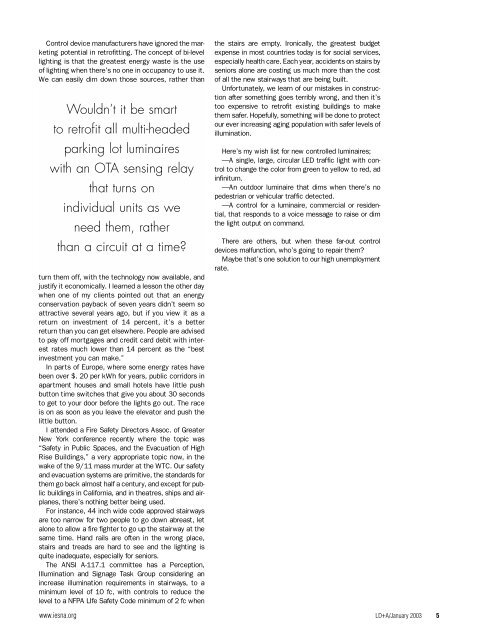From Pokemon to Tiffany's to LEED to DALI - Illuminating ...
From Pokemon to Tiffany's to LEED to DALI - Illuminating ...
From Pokemon to Tiffany's to LEED to DALI - Illuminating ...
You also want an ePaper? Increase the reach of your titles
YUMPU automatically turns print PDFs into web optimized ePapers that Google loves.
Control device manufacturers have ignored the marketing<br />
potential in retrofitting. The concept of bi-level<br />
lighting is that the greatest energy waste is the use<br />
of lighting when there’s no one in occupancy <strong>to</strong> use it.<br />
We can easily dim down those sources, rather than<br />
Wouldn’t it be smart<br />
<strong>to</strong> retrofit all multi-headed<br />
parking lot luminaires<br />
with an OTA sensing relay<br />
that turns on<br />
individual units as we<br />
need them, rather<br />
than a circuit at a time<br />
turn them off, with the technology now available, and<br />
justify it economically. I learned a lesson the other day<br />
when one of my clients pointed out that an energy<br />
conservation payback of seven years didn’t seem so<br />
attractive several years ago, but if you view it as a<br />
return on investment of 14 percent, it’s a better<br />
return than you can get elsewhere. People are advised<br />
<strong>to</strong> pay off mortgages and credit card debit with interest<br />
rates much lower than 14 percent as the “best<br />
investment you can make.”<br />
In parts of Europe, where some energy rates have<br />
been over $. 20 per kWh for years, public corridors in<br />
apartment houses and small hotels have little push<br />
but<strong>to</strong>n time switches that give you about 30 seconds<br />
<strong>to</strong> get <strong>to</strong> your door before the lights go out. The race<br />
is on as soon as you leave the eleva<strong>to</strong>r and push the<br />
little but<strong>to</strong>n.<br />
I attended a Fire Safety Direc<strong>to</strong>rs Assoc. of Greater<br />
New York conference recently where the <strong>to</strong>pic was<br />
“Safety in Public Spaces, and the Evacuation of High<br />
Rise Buildings,” a very appropriate <strong>to</strong>pic now, in the<br />
wake of the 9/11 mass murder at the WTC. Our safety<br />
and evacuation systems are primitive, the standards for<br />
them go back almost half a century, and except for public<br />
buildings in California, and in theatres, ships and airplanes,<br />
there’s nothing better being used.<br />
For instance, 44 inch wide code approved stairways<br />
are <strong>to</strong>o narrow for two people <strong>to</strong> go down abreast, let<br />
alone <strong>to</strong> allow a fire fighter <strong>to</strong> go up the stairway at the<br />
same time. Hand rails are often in the wrong place,<br />
stairs and treads are hard <strong>to</strong> see and the lighting is<br />
quite inadequate, especially for seniors.<br />
The ANSI A-117.1 committee has a Perception,<br />
Illumination and Signage Task Group considering an<br />
increase illumination requirements in stairways, <strong>to</strong> a<br />
minimum level of 10 fc, with controls <strong>to</strong> reduce the<br />
level <strong>to</strong> a NFPA LIfe Safety Code minimum of 2 fc when<br />
www.iesna.org<br />
the stairs are empty. Ironically, the greatest budget<br />
expense in most countries <strong>to</strong>day is for social services,<br />
especially health care. Each year, accidents on stairs by<br />
seniors alone are costing us much more than the cost<br />
of all the new stairways that are being built.<br />
Unfortunately, we learn of our mistakes in construction<br />
after something goes terribly wrong, and then it’s<br />
<strong>to</strong>o expensive <strong>to</strong> retrofit existing buildings <strong>to</strong> make<br />
them safer. Hopefully, something will be done <strong>to</strong> protect<br />
our ever increasing aging population with safer levels of<br />
illumination.<br />
Here’s my wish list for new controlled luminaires;<br />
—A single, large, circular LED traffic light with control<br />
<strong>to</strong> change the color from green <strong>to</strong> yellow <strong>to</strong> red, ad<br />
infinitum.<br />
—An outdoor luminaire that dims when there’s no<br />
pedestrian or vehicular traffic detected.<br />
—A control for a luminaire, commercial or residential,<br />
that responds <strong>to</strong> a voice message <strong>to</strong> raise or dim<br />
the light output on command.<br />
There are others, but when these far-out control<br />
devices malfunction, who’s going <strong>to</strong> repair them<br />
Maybe that’s one solution <strong>to</strong> our high unemployment<br />
rate.<br />
LD+A/January 2003 5

















